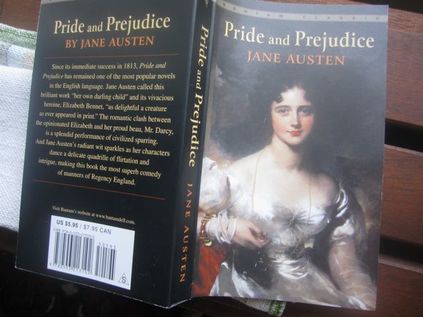
Indexing Pride and Prejudice: Indexing Fiction
This year is the 200th anniversary of Jane Austen’s death, and having read Pride and Prejudice numerous times already, I’ve decided to create an index for it. The classics are ‘classic’ for good reason. (Moby Dick may be my next indexing diversion).
Why index Austen’s Pride and Prejudice? Did I say it’s a fantastic read? (!!), and closer reading with an eye to an index provides the opportunity of linking nuanced first meetings with later plot developments; scenes where character is exhibited through tone of speech (Austen never tells the reader what to think), and the interlacings of relationships between family, friends and lovers.
Being able to refer to an index can quickly restore a new reader to the pattern of plot and relationship, where details of entails - of who is heir to what and why - are extremely important. However, present day readers may not understand what was common knowledge during the Regency period when Austen was writing. In a family of five daughters and no sons, the entrance of the distantly-related Mr. Collins is of high dramatic value. Mr. Collins makes his first entrance only on page 52 of the Bantam Classics edition (reissue 2003, based on the 1813 edition).
A problem for indexing is that there is no standard pdf format to work from. I’m guessing from a rudimentary Internet search, that there are thousands of editions extant in multiple languages and formats, so that whatever I create the page numbers will be irrelevant. However, I believe that the index itself will not be irrelevant, and that publishers ought to be more interested in creating indexes for classic literature. They provide a way for new readers to orient themselves to multiple plot lines, character development, and family relationships that only become clear over time. To me, it is one future for indexing that hasn’t yet been adopted. (See button below "Index first draft")
The first read through of a novel is usually for storyline. If it’s a great book it can be re-read for multiple reasons such as: How is character revealed? What’s been omitted in the movie version? What was the first interaction between Darcy and Elizabeth? What was that great conversation between them at Netherfield? How do we know that Bingley truly admires Jane? Where are the first stirrings of Lydia’s narcissism underlined? At what point can we be sure that Darcy is the man who will always come through? Where do the intimations of ‘Pride’ and ‘Prejudice’ show themselves? How great is “Death Comes to Pemberley” PD James’ follow up? And then the BBC version of it? And the latest BBC Culture facebook post [https://www.facebook.com/BBCCulture/videos/1425986837485085/?hc_ref=ARQQ6l2sJi9aHEWHlzx8iuTrNbOHsgOdkaoKgAT6LB0bynYDVwYrpNAMs-uSYM1d6rI], not to mention Pride and Prejudice (and Vampires), all these keep regenerating Pride and Prejudice in ways Austen could never have imagined. An index is a no-brainer for added value.
More on the topic as I get past Mr. Collins entrance pages 52-73.
This year is the 200th anniversary of Jane Austen’s death, and having read Pride and Prejudice numerous times already, I’ve decided to create an index for it. The classics are ‘classic’ for good reason. (Moby Dick may be my next indexing diversion).
Why index Austen’s Pride and Prejudice? Did I say it’s a fantastic read? (!!), and closer reading with an eye to an index provides the opportunity of linking nuanced first meetings with later plot developments; scenes where character is exhibited through tone of speech (Austen never tells the reader what to think), and the interlacings of relationships between family, friends and lovers.
Being able to refer to an index can quickly restore a new reader to the pattern of plot and relationship, where details of entails - of who is heir to what and why - are extremely important. However, present day readers may not understand what was common knowledge during the Regency period when Austen was writing. In a family of five daughters and no sons, the entrance of the distantly-related Mr. Collins is of high dramatic value. Mr. Collins makes his first entrance only on page 52 of the Bantam Classics edition (reissue 2003, based on the 1813 edition).
A problem for indexing is that there is no standard pdf format to work from. I’m guessing from a rudimentary Internet search, that there are thousands of editions extant in multiple languages and formats, so that whatever I create the page numbers will be irrelevant. However, I believe that the index itself will not be irrelevant, and that publishers ought to be more interested in creating indexes for classic literature. They provide a way for new readers to orient themselves to multiple plot lines, character development, and family relationships that only become clear over time. To me, it is one future for indexing that hasn’t yet been adopted. (See button below "Index first draft")
The first read through of a novel is usually for storyline. If it’s a great book it can be re-read for multiple reasons such as: How is character revealed? What’s been omitted in the movie version? What was the first interaction between Darcy and Elizabeth? What was that great conversation between them at Netherfield? How do we know that Bingley truly admires Jane? Where are the first stirrings of Lydia’s narcissism underlined? At what point can we be sure that Darcy is the man who will always come through? Where do the intimations of ‘Pride’ and ‘Prejudice’ show themselves? How great is “Death Comes to Pemberley” PD James’ follow up? And then the BBC version of it? And the latest BBC Culture facebook post [https://www.facebook.com/BBCCulture/videos/1425986837485085/?hc_ref=ARQQ6l2sJi9aHEWHlzx8iuTrNbOHsgOdkaoKgAT6LB0bynYDVwYrpNAMs-uSYM1d6rI], not to mention Pride and Prejudice (and Vampires), all these keep regenerating Pride and Prejudice in ways Austen could never have imagined. An index is a no-brainer for added value.
More on the topic as I get past Mr. Collins entrance pages 52-73.
| index_pride_and_prejudice.pdf |
 RSS Feed
RSS Feed